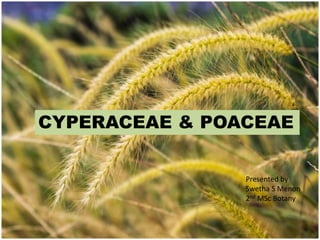
CYPERACEAE AND POACEAE.pptx
- 1. CYPERACEAE & POACEAE Presented by Swetha S Menon 2nd MSc Botany
- 2. INTRODUCTION • Cyperaceae This family includes 90 genera and 4000sps widely distributed over all parts of the world.In India the family represnted by 22 genera and 405 sps throughout the country and abundant in the plains .The best known examples are Chufas [Cyperus esculntus L.], Umberlla plant [Cyperus alternifolius L.], Sedge [Cyperus rotundus] and Cotton sedge [Eriophrum sps]
- 3. • They are grass or rush-like mostly perinnial herbs ,abundant in wet and marshy places. The plant persist by means of an underground creeping sympodial rhizome which some times bears tubers as in Cyperus esculentus and Cyperus rotundus
- 5. • Poaceae [Gramineae] The Poaceae are one of the largest and most important family of the plant kingdom .They contain about 600 genera and over 10,000 sps,widely distributed all over the world .They show greater adaptibility and thrive under the most varied conditions,ocurring from artic to antartic ,from sea level to high mountain ,from fresh water of lakes and rivers to blackish situations on the coast and under extreme desert conditions.
- 6. This is the largest family of Indian flora and is represnted by about 239 genera and 1,180 sps ocurring throughout the country from sea level to an elavation of about 6,000meters in the Himalayas. The familiar examples includes Wheat [Triticum aestivum L.], Rice [Oryza sativa L.], Maize [Zea mays L.], Sugarcane [Saccharum officinarum L.] and Bamboos [sps of Bambusa,Dendroclamus etc.]
- 7. • Most of the grasses are annuel,biennial or most frequently perennial herbs. The range in height from less than 2 cm to 6 m[ savanna grasses of the tropics].They are rarely shrubs or trees with woody steamwhich attain a height of 30 m or more is Asiatic bamboos.Some bamboos have a life cycle up to more than 100 yrs
- 8. wheat Rice maize Sugarcane Bamboo
- 9. SYSTAMATICS & PHLOGENY •Cyperaceae The Cyperaceae were included in the series of Glumaceae by Bentham & Hooker. In Engler’s classification they were included in the order Glumiflorae alongwith the Gramineae. The two families were placed in a single order Cyperales by Cronquist. Hutchinson and Takthajan placed the families into separate orders Cyperales and Graminales or Poales The Cyperaceae are usually considered as closely allied to the Graminae.However,studies of
- 10. Snell [1936] and Blaser [1941, 1944] pointed out that the Cyperaceae and Gramineae are not closely related and differ from each other in several respects. According to Cronqusit [1968,1981] the chemical similarities between the two families are more suggestive of phyletic unity than convergence The familiy is considered to have been derived from Liliales[ Blaser] or from the Juncaceae [Cronqusit & Takthajan]
- 11. • Poaceae Bentham & Hooker divided the family into two subfamilies , Panicaceae & Poaceae, the former Includes six and the latter seven tribes. They placed the family alongwith the Cyperaceae in the series Glumaceae. In Engler’s system the two families were included in th order Glumiflorae,and Cronquist placed them in his Cyperales. Hutchinson and Takthajan placed the family in an order of its own which they named as Graminales and Poales respectively. The Poaceae are one of the most successful families of the flowering plants with reduced flowers adapted for wind pollination.They are considered to be very advanced group of angiosperms and evolved from primitive liliaceous ancestral stocks
- 12. COMPARISON OF CYPERACEAE & POACEAE[GRAMINEAE] POACEAE Stem- Cylindrical,hallow[expect maize and sugarcane]with nodes Leaves- Simple,alternate,ligulate,sheat h split open Flower- flowers subtended by two glumes Scales- glumes,lemma,palaea Perianth – represented by 2-3 lodicules CYPERACEAE Stem- Triangular,solid,without nodes Leaves- Simple,ligule absent,closed sheath Flower-only one glume Scales- pistillate staminate scales Perianth- Absent and presented by scales or bristles
- 13. Stemens –usually 3,rarely 1, basifixed Pistil- Tricarpellary, syncarpous, one celled, single basal ovule Fruit- Achene or nut Floral formula- Stemens- normally 3, rarely3+3 , versatile Pistil- Monocarpellary,one loculed ,one ovuled Fruit- Caryopsis Floral formula -
- 16. ECNOMIC IMPORTANCE CYPERACEAE Cyperus esculentus L. and Scripus grossus L.f var.kysoor Roxb. are grown for their edible tubers known as Chufa or Kaseru. The tubers of Eleochairs dulcis Trin. [Chinese water chestnut] are also edible The dried tubers of some sps such as Cyperus rotundus L. [Motha] and Cyperus scariosus Br. are used in medicine and perfumer Several sps of Cyperus,Kyllinga and Carex mak good fodder
- 17. Rhynechospora corymbosa Britton is used as green manure The pith from culms of Cyperus papyrus L.[Papyrus] was used by Egyptians in older times for paper making The cottony perianth of th flowers of Eriophorum [ cotton sedge] is used for stuffing pillows etc. The leaves and stems of several sps of Scirpus are used for wicker-work .Some sps are soil binders and help in natural conservation of shallow water areas into lands for agriculture. A few sps such as Cyperus alterrnifolius L. and Cyperus flabelliformis Rott.[umberalla plant ] are grown as ornamentals
- 18. ECNOMIC IMPORTANCE POACEAE[GRAMINEAE] Grains of most plants are used as food Eg; Wheat,Rice,Maize, Ragi etc. Essential oils obtained from different sps of Crymbopogon.Citronlla oil from Crymbopogon nardus,lemon grass oil from C.citratus,ginger grass oil from C.flexuosus,geranium grass oil from C.martin. These oils are used in medicines,which have antibacterial,antifungal or antiseptic properties Cane sugar obtained from the sugary internod of Saccharum officinarum,is th best source of energy
- 19. Leaves and stems of Bamboo and Rheeds are used to construct and thatch houses, their pulp is used in the manufacture of paper Vetiver oil obtained from Vetiveria is medicinally used oil.Khus-Khus obtained from grains used as a flavouring material . Cynodon is medicinal used to treat nervous diseases Dactylis is an ornamental grass Broom grass is used to make broom Dye, Canada blue, obtained from Poa campressa
